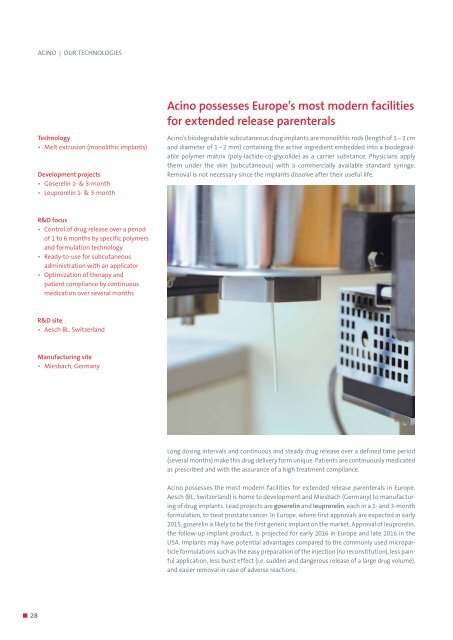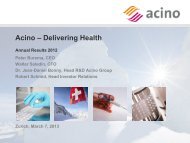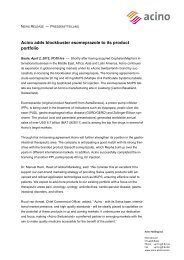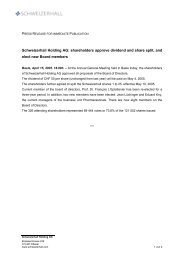Annual Report 2012 - Acino
Annual Report 2012 - Acino
Annual Report 2012 - Acino
You also want an ePaper? Increase the reach of your titles
YUMPU automatically turns print PDFs into web optimized ePapers that Google loves.
28<br />
ACINO | OUR TECHNOLOGIES<br />
Technology<br />
• Melt extrusion (monolithic implants)<br />
Development projects<br />
• Goserelin 1 & 3month<br />
• Leuprorelin 1 & 3month<br />
R&D focus<br />
• Control of drug release over a period<br />
of 1 to 6 months by specific polymers<br />
and formulation technology<br />
• Readytouse for subcutaneous<br />
administration with an applicator<br />
• Optimization of therapy and<br />
patient compliance by continuous<br />
medication over several months<br />
R&D site<br />
• Aesch BL, Switzerland<br />
Manufacturing site<br />
• Miesbach, Germany<br />
<strong>Acino</strong> possesses Europe’s most modern facilities<br />
for extended release parenterals<br />
<strong>Acino</strong>’s biodegradable subcutaneous drug implants are monolithic rods (length of 1 – 2 cm<br />
and diameter of 1 – 2 mm) containing the active ingredient embedded into a biodegradable<br />
polymer matrix (polylactidecoglycolide) as a carrier substance. Physicians apply<br />
them under the skin (subcutaneous) with a commercially available standard syringe.<br />
Removal is not necessary since the implants dissolve after their useful life.<br />
Long dosing intervals and continuous and steady drug release over a defined time period<br />
(several months) make this drug delivery form unique. Patients are continuously medicated<br />
as prescribed and with the assurance of a high treatment compliance.<br />
<strong>Acino</strong> possesses the most modern facilities for extended release parenterals in Europe.<br />
Aesch (BL, Switzerland) is home to development and Miesbach (Germany) to manufacturing<br />
of drug implants. Lead projects are goserelin and leuprorelin, each in a 1 and 3month<br />
formulation, to treat prostate cancer. In Europe, where first approvals are expected in early<br />
2015, goserelin is likely to be the first generic implant on the market. Approval of leuprorelin,<br />
the followup implant product, is projected for early 2016 in Europe and late 2016 in the<br />
USA. Implants may have potential advantages compared to the commonly used microparticle<br />
formulations such as the easy preparation of the injection (no reconstitution), less painful<br />
application, less burst effect (i.e. sudden and dangerous release of a large drug volume),<br />
and easier removal in case of adverse reactions.








